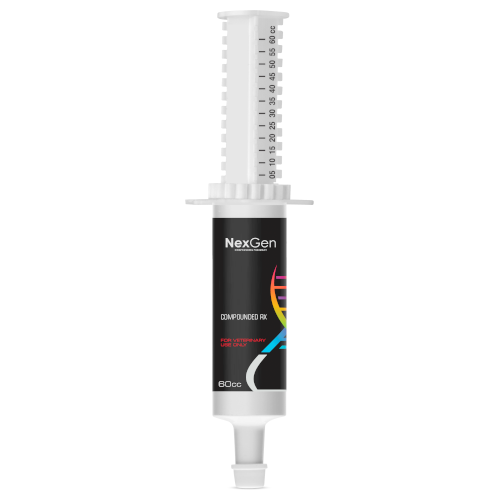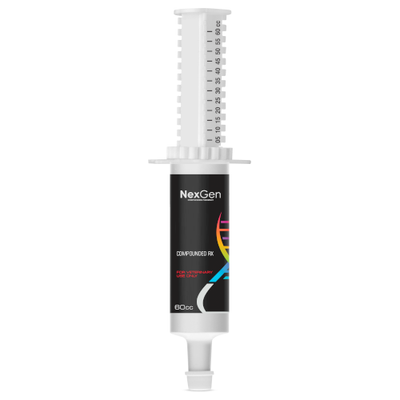
Tryptophan (L) 200 mg/mL, Oral Paste, 60mL Syringe
Login for pricing
- Brand
- Mixlab
- SKU:
- NC-0327
- Product Type:
- Paste
- Size:
- 60ml
- Administration:
- Oral
Excitability in the horse is a common problem, and one which can have many potential causes. These can include genetic predisposition (a horse’s breed), environmental factors, experience and learning, management and nutrition. In most cases, multiple factors are believed to play a role in horses’ excitability.1 Since the environment of managed horses and modern husbandry is far different from a horse’s natural environment, the above factors along with training and competition demands can exacerbate excitable behavior in some horses. This can negatively affect performance horses, and even those used for recreation.
There are many symptoms of excitability in horses that have been noted, some of which include:
- Hyperactivity
- Overreaction to external stimuli
- Fearfulness
- Inclination to “spook”
- Lacking of focus
- Fractiousness
- Resistance to training
- Difficulty in riding
- Reluctance in clipping, shoeing or traveling2
One recent study suggested that stroking horses (a common activity used to reward or to show affection), might actually cause or exacerbate excitability in horses, depending upon where on the body a horse is stroked and the duration thereof.3 Changes in husbandry, training and diet have been known to benefit excitable horses. Today, diet is often focused upon as the primary controllable factor in the quest to manage excitable horses, however, without a complete understanding of all potential factors, it has become easy for horse owners and managers to single out nutrition as the main causative factor in excitability.
Calming Agents
In some sectors of the performance horse industry, psychotropic drugs—sedatives and tranquilizers—have been used to manage excitable horses. These “calming agents” are typically used to “take the edge off” excitable horses in order to improve their manageability, and hence, their performance. While some use psychotropic drugs temporarily to help horses through stressful situations (e.g., traveling, experiencing fireworks), others seldom allow their horses to compete without chemical assistance.2
Most of the behavior-altering drugs used in horses have come from human medicine. Drugs like acepromazine and chlorpromazine were originally antipsychotic drugs used to treat mental illnesses such as schizophrenia and bipolar disorder, while guanabenz is an antihypertensive used to control blood pressure in humans.
Obviously, the use of psychotropic drugs to calm horses, particularly in the long term, is viewed as highly unethical by some. Additionally, most owners and managers would prefer not to have perpetually “drugged-up” horses if given the choice.
Manageable Factors
Some of the factors that can be fairly easily managed by horse owners as first-line remedies, and which come widely recommended include:
- Regular daily exercise (since horses are not naturally used to being stalled for long periods)
- Increasing turnout (allowing the horse to interact with other horses as an outlet for stress)
- Buddy Horse (some excitable horses settle calm down once they have a buddy)
- Familiarization with environment (allowing time for a horse to adjust to a new environment can help reduce its anxiety)
Diet and Excitability
How a horse breaks down and stores energy depends on the composition of its diet. Structural carbohydrates (fiber) pass through the horse’s small intestine undigested and undergo microbial fermentation in the hindgut. There, they form volatile fatty acids (VFAs) such as acetate, butyrate, and propionate.1 A horse can metabolize some VFAs while others must be further digested prior to being usable.
Nonstructural carbohydrates (NSCs, or hydrolysable carbohydrates) are found in cereal grains and in pastures. These include sugars, starches, and fructans (grass sugars). These are broken down by enzymes in the small intestine into glucose, which passes through the intestinal wall and into the bloodstream.1,2 This causes the horse’s blood glucose to rise until insulin signals reuptake by cells for storage. Meals with a high sugar or starch content elevate glucose levels for a longer period of time. These elevated glucose levels are thought to contribute to excitability by triggering a horse’s “fight or flight” response, as this tends to mimic the dynamic associated with cortisol (a stress hormone) levels.2
Some dietary recommendations from Purina-Cargill Animal Nutrition for rations that are less likely to excite horses include:
- Choosing a feed containing at least 15% fibre and beet pulp or soy hulls in the list of ingredients. This will provide a readily-digestible fiber that is also a source of energy.
- Providing sufficient levels of fat.
- Carefully reading any feed’s ingredient list and guaranteed analysis, noting NSC levels, the feed contents and its source of energy.
- Providing feeds with sufficient vitamins and minerals.
- Providing sufficient hydration, as dehydrated horses often show signs of excitability.
Tryptophan for Excitability in the Horse
Tryptophan is an essential amino acid required to form the neurotransmitter serotonin, which is important for normal brain function and particularly is associated with reduced fearfulness and aggression.4 Serotonin is related to sedation and lower levels of fear, stress, and aggression in humans and some animal species. Tryptophan has been the subject of many recent studies, and has been offered as a remedy for depression in humans as well as a natural calming agent for horses.6
Unlike drugs, tryptophan is not directly active as a calming agent, but is utilized by the horse’s body to manufacture the chemical compounds that aid in calming. Once tryptophan is absorbed and in the bloodstream, it crosses into the brain and is synthesized into serotonin.5 Serotonin is responsible for signal transmission between nerve cells and acts as a chemical messenger to keep brain impulses flowing efficiently.
In horses that have not recently consumed a meal, it usually takes between 20 to 30 minutes for tryptophan to be absorbed from the intestinal tract. The maximum level of serotonin in the brain comes about approximately 2 to 3 hours following the ingestion of supplemental tryptophan. Once the serotonin level in the brain reaches its maximum level, it tapers off gradually. The calming effect of tryptophan is likely to be the most effective during the 12 hour period after it is ingested by the horse.5
Long term supplementation with tryptophan is also safe and may be given daily. When it is given twice daily for three days, blood levels become constant with minimal fluctuation.5 This is a recommended daily feeding method for horses that are sensitive to stress.
Where to buy Tryptophan
Tryptophan is available in the U.S. through pharmaceutical manufacturers and through veterinary custom compounding companies. TRYPTOPHAN 200 MG/ML Oral Paste by NexGen Pharmaceuticals is an excellent, natural choice for addressing excitability in the horse.
Please consult your veterinarian prior to beginning any treatment regimen.
FOR RX ONLY: A valid prescription from a licensed veterinarian is required for dispensing this medication.
2Cooper, J.J., Albentosa, M.J. 2005. Behavioural adaptation in the domestic horse: potential role of apparently abnormal responses including stereotypic behaviour. Livest. Prod. Sci. 92: 177–182
3Janczarek, I., et. al. (2018). Emotional excitability and behaviour of horses in response to stroking various regions of the body. Animal Science Journal. 89. 10.1111/asj.13104.
4Engle, T., et. al. Preliminary evaluation on the effectiveness of varying doses of supplemental tryptophan as a calmative in horses. Applied Animal Behaviour Science, Volume 188, March 2017, Pages 34-41.
6Shaw K, Turner J, et al. Tryptophan and 5-hydroxytryptophan for depression. Cochrane Database Syst Rev. 2002;(1):CD003198.









